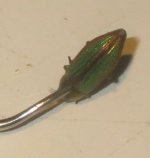rimcanyon
Diamond
- Joined
- Sep 28, 2002
- Location
- Salinas, CA USA
Two years ago I bought a trailer load of rough cut douglas fir 4x6's from a sawmill in Bonny Dune, near Santa Cruz. I wanted them for posts, beams, blocking and door stock, and there was a mix of 100% heartwood boards and boards that had rounded corners or sides with the cambium under-bark layer exposed and about 50% sapwood. I waxed the endgrain just like an Ipe deck board, stickered and banded the boards and left them under a tarp to dry.
Last week I pulled out all the boards, jointed and planed them to be straight and a consistent dimension (it didn't take a lot to get them straight, and the wax did a good job of preventing checking). However, all of the boards with cambium layer exposed were infested with beetles
 . And not a variety of beetle I am familiar with:
. And not a variety of beetle I am familiar with:



I should have sprayed timbor or similar onto the boards before putting them to dry. I don't think there is anything you can do to kill an infestation of beetles, so all of the boards with exposed cambium are getting burned or taken to the dump. Fortunately the pure heartwood boards are still good and I got some good vertical grain door stock. Next time I will know better than to buy boards with the cambium layer still intact.
Another thing I learned is that you cannot tell how badly a board is infested just by looking at the surface. Apparently the beetles lay their eggs inside the wood, so even if there are only one or two exit holes, the board may be riddled with holes inside. I cut up some of the 4x6's to 1x boards and found bore holes throughout, even where the wood looked good on the outside. It makes me think the boards were probably infested when I bought them.
-Dave
Last week I pulled out all the boards, jointed and planed them to be straight and a consistent dimension (it didn't take a lot to get them straight, and the wax did a good job of preventing checking). However, all of the boards with cambium layer exposed were infested with beetles

 . And not a variety of beetle I am familiar with:
. And not a variety of beetle I am familiar with:


I should have sprayed timbor or similar onto the boards before putting them to dry. I don't think there is anything you can do to kill an infestation of beetles, so all of the boards with exposed cambium are getting burned or taken to the dump. Fortunately the pure heartwood boards are still good and I got some good vertical grain door stock. Next time I will know better than to buy boards with the cambium layer still intact.
Another thing I learned is that you cannot tell how badly a board is infested just by looking at the surface. Apparently the beetles lay their eggs inside the wood, so even if there are only one or two exit holes, the board may be riddled with holes inside. I cut up some of the 4x6's to 1x boards and found bore holes throughout, even where the wood looked good on the outside. It makes me think the boards were probably infested when I bought them.
-Dave



